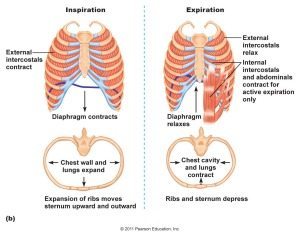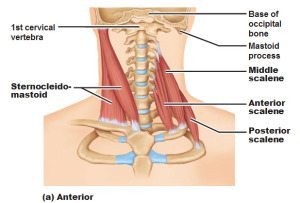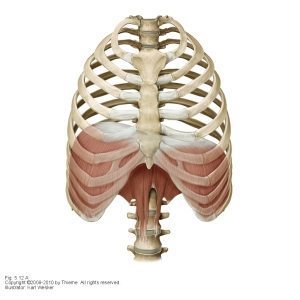Breathing: Belly Breathing Does Not Exist
Breathing is one of the most natural things we are designed to do. Yet, we complicate it. We should breathe in, breathe out. Simple. But are you really using the primary breathing muscle? What is the quality of your breath? Is it deep? Shallow? Low? High? There is a lot of poor information circulating in regards to breathing. And, I’m not sure why. Anatomy is anatomy, so why complicate it? For example, belly breathing is a main breathing exercise prescribed. Let me save you some time. There are no breathing muscles in our belly. Not one. There is one primary breathing muscle that drives respiration: The Diaphragm. Do you think you’re using it to breathe?
Unfortunately, most of us are not. And, a lot of unexplained, chronic pain and stress is directly related to inefficient breathing.
RESPIRATION = BREATHING
There are two phases of respiration. Inspiration and Expiration. The first goal is to get oxygen from the outside air and deliver it to our red blood cells. The second step is to remove carbon dioxide from the cells and deliver it back out into the environment. That’s it. That is why we breathe. Unfortunately, most of us do a poor job at this simple task. And, our poor breathing performance leads to low back pain, neck pain, shoulder pain, posture dysfunction and decreased athletic performance. Hmm…
MUSCLES OF INSPIRATION = BREATHING IN
These muscles work to expand the ribcage. This expansion creates a negative pressure in the lungs. This negative pressure forces air from the environment into our lungs.
- Diaphragm
- External intercostals
- Sternocleidomastoid (SCM) (accessory muscle)
- Scalenes (accessory muscle)
- Transverse abdominis and pelvic floor
MUSCLES OF EXPIRATION = BREATHING OUT
Expiration is a passive event most of the time, meaning we don’t have to work to breathe out. However, when we want to forcefully get air out (exercise, stress release), these muscles do the work.
These muscles work to deflate the ribcage and push air out of the lungs.
- Internal intercostals
- Inner 2 abdominal layers: transverse abdominis, internal abdominal oblique
- Pelvic floor
HIGH NECK BREATHING = HOW MOST OF US ARE BREATHING
Here’s the problem. Most of us only breathe with our SCM and scalenes. These are accessory muscles to breathing that expand the upper part of the rib cage. They are not the primary breathing muscles! They are primarily neck muscles. (Have any unexplained neck pain?)
So what does it mean if you’re using your neck to breathe? It means the breath remains high, shallow and only expands the first few ribs. It also means the remaining ribs of the thoracic cage are not expanding. Poor expansion of the rib cage decreases the capacity for the lungs to fill with air. If the lungs don’t fill with an optimal amount of air, less oxygen enters the body. Diminished oxygen to the body is not good.
High neck breathing is inefficient and can lead to pain, health issues, stress and sub-optimal athletic performance.
HOW ARE YOU REALLY BREATHING?
If you can, find a mirror so you can watch yourself breathe. The camera on your phone works too! Without thinking too much, take a deep breath in. Did your shoulders raise up? Take another breath in. Is most of the rib movement in your upper chest? If you find your breath high (maybe you didn’t even know it), there is one very important muscle I’d like to introduce you to: The Diaphragm.
THE DIAPHRAGM = PRIMARY BREATHING MUSCLE
The diaphragm is a thin, flat, dome-shaped muscle that separates the thoracic cavity (lungs) from the abdominal wall (organs). It has attachments to the lumbar spine and lower 6 ribs. It’s vast and well-anchored on bones to perform its job. It’s actually considered one of the core muscles.
Notice those muscle insertions on the spine. They are called cruae and attach to the thoracolumbar fascia (low back fascia) and give the diaphragm stability to behave as part of the core.
When the diaphragm contracts it causes a downward force toward the abdominal cavity. This is when the belly will rise a little bit. I think this is where belly breathing has become misinterpreted. The diaphragm is the driver of the breath, and the belly makes some room for the diaphragm to lower.
While the diaphragm contracts, the lower 6 ribs lift and rotate out to expand the rib cage and allow more air to enter the lungs.
Using the diaphragm is our best chance for an optimal and efficient breath. Period.
Diaphragmatic breathing is not a new concept. Singers are excellent at breathing with their diaphragm. It’s the only way they can get consistent, controlled and on-pitch vocal tone. Pilates students who master the breathing principle are also good at using the diaphragm. However, for the mass public, we get a big fat F for diaphragm breathing. But, with a little practice and patience, the diaphragm can be part of your life again!
Ok, so are you saying I should be breathing from my diaphragm when I’m running? Sitting in the car? Swimming? Doing housework? Yes, yes, yes and YES!
BLOG ACTIVITY – FINDING YOUR DIAPHRAGM
This can be a little tricky at first, and sometimes frustrating. But, have patience. It will come.
Stand in front of a mirror and place your right hand on your lower left ribs and left hand on the lower right ribs; your arms will cross. It’s like you’re giving yourself a “low hug”. Relax your shoulders. Take a deep breath into your hands to expand the lower ribcage. At first, this may be very slight and the breath will feel shallow. Concentrate on relaxing the neck and shoulders and grounding your breath low. The deep breath sensation will take some time to master. And once you find it, you’ll know. It’s relaxing and deep.
Summary
- Breathe from your diaphragm; it’s the primary breathing muscle.
- Breathe from your diaphragm; it could be the culprit of your low back or neck pain.
- Breathe from your diaphragm; it might improve your sport performance.
© 2017 and Beyond. ALL BLOG CONTENT at duncansportspt.com by Lori Duncan PT
BLOG TALK PODCAST
Breathing – Belly Breathing Does Not Exist
ABOUT THE AUTHOR
 Lori Duncan, DPT, MTC, CPT is a respected physical therapist and Pilates instructor in Lafayette, CO. She is passionate about preventive physical therapy and education. She can be reached at [email protected]. You can also follow on Facebook & Instagram for more free tips and information.
Lori Duncan, DPT, MTC, CPT is a respected physical therapist and Pilates instructor in Lafayette, CO. She is passionate about preventive physical therapy and education. She can be reached at [email protected]. You can also follow on Facebook & Instagram for more free tips and information.
References:
Bradley H, Esformes J. Breathing pattern disorders and functional movement. Int J Sports Phys Ther. 2014;9:28-39.
Ratnovskya A, Eladb D, Halpern P. Mechanics of respiratory muscles. Respir Physiol Neurobiol. 2008:82-89.




